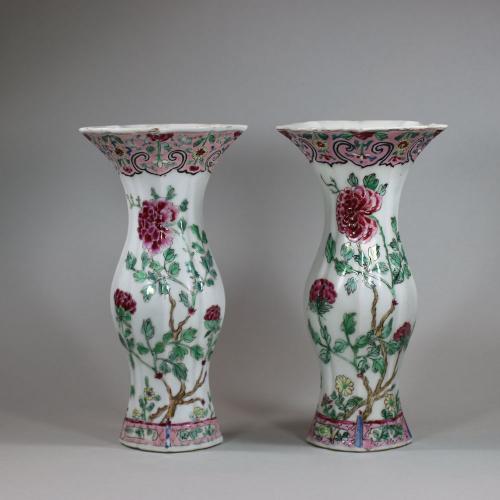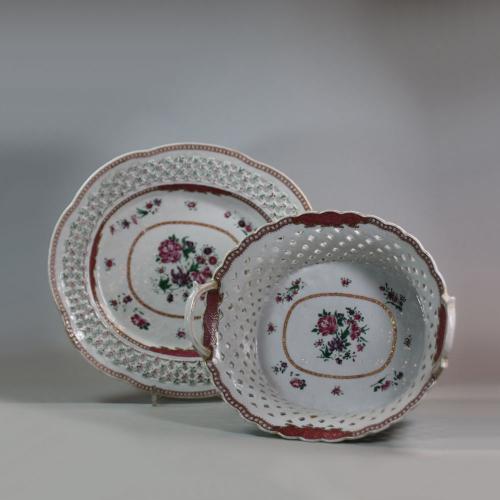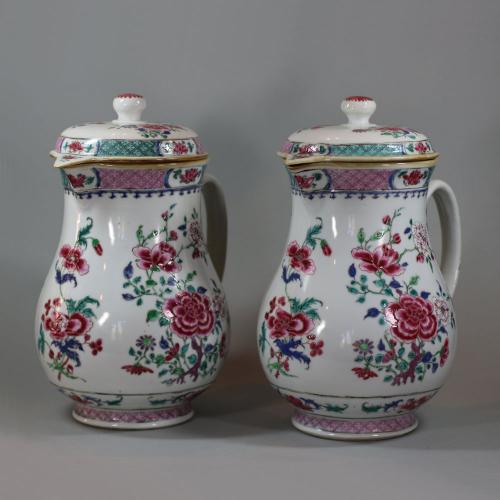
Price on application
This object is eligible for a Certificate of BADA Provenance
The BADA Standard
- Since 1918, BADA has been the leading association for the antiques and fine art trade
- Members are elected for their knowledge, integrity and quality of stock
- Our clients are protected by BADA’s code of conduct
- Our dealers’ membership is reviewed and renewed annually
- Bada.org is a non-profit site: clients deal directly with members and they pay no hidden fees
Chinese famille rose armorial dish, Qianlong (1736-95), the central well enamelled with the arms of Swellengrebel, with a central gold shield bearing a fleur-du-lis surmounted by a knight's helmet crest amongst pink and red feathers; the cavetto with four floral cartouches against a pink diaper ground with single yellow flowerheads, the rim with a crown and stag horn crest, and sprays of peony and primrose within a further pink diaper band to the rim.
Diameter: 22cm. (8 5/8in.)
Condition:
Sliver chip with associated hairline approx 5.5cm. (2 1/4in.) and another faint hairline of 4 cm.
Notes:
This dish bears the coat of arms of Swellengrebel and was probably part of a dinner service made for Sergius Swellengrebel (1694-1760), a member of the prominent Dutch colonial Swellengrebel family associated with the Cape of Good Hope during Dutch East India Company (VOC) rule. His uncle, Johannes Swellengrebel, had been born in Moscow into a branch of the family which had risen to great prosperity as part of the Dutch expatriate community there. In 1691, at the age of 20, Johannes moved to the Cape of Good Hope under the patronage of a powerful Dutch statesman and, with good connections and ties to influential VOC figures, was swiftly promoted. His son Henrik (1700-1760) followed in his footsteps and in 1739 was appointed Governor of the colony. Sergius Swellengrebel had been born in the Netherlands but joined his cousin at the Cape of Good Hope in 1712, where he remained for ten years before returning to Europe. Later he re-entered the service of the VOC and did well, rising through the ranks and becoming senior merchant and deputy governor or ‘secunde’ of the Cape in 1750. As secunde, he played a crucial role in the administration and governance of the Cape, which at this time was a critical link in the VOC’s global trade network, facilitating the flow of goods, people, and information between Europe and Asia. While a variety of luxury goods from the ships were enjoyed by the Dutch inhabitants of the colony, the popularity of armorial porcelain in particular reflected the tastes and aspirations of the colonial elite and their desire to connect with European nobility through their coats of arms.
For an illustrated discussion of this service, see Kroes, Jochem Kroes (2007) Chinese Armorial Porcelain for the Dutch Market (W Books) p.178
Dimensions
Diameter: 22cm. (8 5/8in.)Condition report
Sliver chip with associated hairline approx 5.5cm. (2 1/4in.) and another faint hairline of 4 cm.Stock number
W632The BADA Standard
- Since 1918, BADA has been the leading association for the antiques and fine art trade
- Members are elected for their knowledge, integrity and quality of stock
- Our clients are protected by BADA’s code of conduct
- Our dealers’ membership is reviewed and renewed annually
- Bada.org is a non-profit site: clients deal directly with members and they pay no hidden fees




